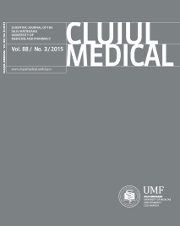p53 siRNA - a therapeutic tool with significant implication in modulation of apoptosis and angiogenic pathways
DOI:
https://doi.org/10.15386/cjmed-434Keywords:
cancer, p53 siRNA, apoptosis angiogenesisAbstract
Background and aims. siRNAs represent an encouraging novel alternative in cancer therapy as a result of targeting the mutated tumour suppressor genes or activated oncogenes. Targeting oncogenic signals, as the mutated p53 gene that gains oncogenic role, we observed inhibition of migration, a downregulation of specific genes involved in apoptosis but also in angiogenesis, connected with a reduction in invasion rate in the case of p53siRNA therapy.
Methods. The study was designed to assess the role of p53 by using RNAi (RNA interference) in Hela in vitro cell culture model. Therefore cell migration rate was assessed by using xCELLigence Systems, gene expression for a panel of genes involved in apoptosis and angiogenesis, and validation of gene expression data at protein level.
Results. On the selected in vitro model p53 siRNA therapy was correlated with the reduction of cell migration. The downregulation of p53, PTEN, TNFα, NFkB, BCL-2, ICAM-2, VEGF, and FGFb was evidenced as response to p53 inhibition.
Conclusion. RNAi may be a valuable technology in order to restore the normal cellular phenotype. The results in the current research may also have an important significance outside the context of cervical cancer, by using specific inhibitors for p53 for increasing the therapeutic response in a wide range of tumoral pathology.
Downloads
Additional Files
Published
How to Cite
Issue
Section
License
The authors are required to transfer the copyright of the published paper to the journal. This is done by agreeing to sign the Copyright Assignment Form. Whenever the case, authors are also required to send permissions to reproduce material (such as illustrations) from the copyright holder.

The papers published in the journal are licensed under a Creative Commons Attribution-NonCommercial-NoDerivatives 4.0 International License.

